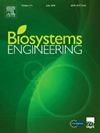Remit of Biosystems Engineering: research in the physical sciences and engineering to understand, model, process or enhance biological systems for sustainable developments in agriculture, food, land use and the environment. Topics are broadly classified under the following nine Interest Fields and each paper is allocated to the most appropriate category. Automation and Emerging Technologies (AE) - intelligent machines; automatic control; navigation systems; image analysis; biosensors; sensor fusion; engineering for biotechnology; Information Technology and the Human Interface (IT) - communications and field bus protocols; ergonomics; geographical information systems; operational research; biosystem modelling and decision support; machinery management; risk and environmental assessment; operator health and safety; work science; Precision Agriculture (PA) - agro-meteorology; food, fibre and forage crop production; extra-terrestrial bioproduction; yield, weed and soil mapping; geographical positioning systems; input reduction; integrated pest management; Power and Machinery (PM) - tillage and earthmoving equipment; machines for the establishment, protection and harvesting of field, protected, and orchard crops; tractors and agricultural vehicles; dynamics, vibration and noise; forest engineering; hydraulics and turbomachinery; clean technology; Postharvest Technology (PH) - properties of biomaterials; crop drying, processing and storage; opto-electronic size grading; ripeness, quality, damage and disease detection with optical reflectance, nuclear magnetic resonance and X-ray tomography; food packaging and processing; food chain integrity and foreign body detection; Structures and Environment (SE) - design of buildings and control of their environment; livestock housing; dust and odour control; crop stores; horticultural glasshouses and plasticulture; composting and waste treatment; gaseous emissions; Animal Production Technology (AP) - livestock welfare and ethology; health monitors; robotic milking and shearing; feed handling; animal draught; integrated stock management; stock handling, weighing, transport and slaughter; meat processing; Soil and Water (SW) - soil structure and properties; soil dynamics in tillage, traction and compaction; soil erosion control; crop water requirements; infiltration and transport processes; irrigation and drainage; hydrology; water resource management; hydroponics and nutrient status; Rural Development (RD) - renewable energy; pollution control; protection of the rural environment; infrastructure and landscape; sustainability.
